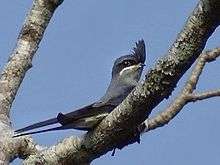Treeswift
Treeswifts or crested swifts are a family, Hemiprocnidae, of aerial near passerine birds, closely related to the true swifts. The family contains a single genus, Hemiprocne, with four species. They are distributed from India and South East Asia through Indonesia to New Guinea and the Solomon Islands.
| Treeswifts | |
|---|---|
 | |
| Crested treeswift (Hemiprocne coronata) | |
| Scientific classification | |
| Kingdom: | Animalia |
| Phylum: | Chordata |
| Class: | Aves |
| Order: | Apodiformes |
| Family: | Hemiprocnidae Oberholser, 1906 |
| Genus: | Hemiprocne Nitzsch, 1829 |
| Species | |
|
See text. | |
Treeswifts are small to medium-sized swifts, ranging in length from 15–30 cm. They have long wings, with most of the length coming from the length of the primaries; their arms are actually quite short. They visibly differ from the other swifts in matters of plumage, which is softer, and they have crests or other facial ornaments, and long forked tails.[1] Anatomically they are separated from the true swifts by skeletal details in the cranium and palate, the anatomy of the tarsus, and a non-reversible hind toe which is used for perching on branches (an activity that true swifts are unable to engage in). The males have iridescent mantle plumage. They also have diastataxic wings, that is they lack a fifth secondary feather unlike swifts in the Apdodini which are eutaxic.[2][3]
.jpg)
The treeswifts exhibit a wide range of habitat preferences. One species, the whiskered treeswift, is a species of primary forest. Highly manoeuvrable, it feeds close to vegetation beneath the canopy, and only rarely ventures into secondary forests or plantations, but never over open ground. Other species are less restricted; the crested treeswift makes use of a range of habitats including humid forests and deciduous woodland, and the grey-rumped treeswift occupies almost every habitat type available from the mangrove forests to hill forests. All species feed on insects, although exact details of what prey are taken has not been studied in detail.
Nest building responsibilities are shared by the male and female. They lay one egg in the nest, which is glued to an open tree branch.[1] Egg colour varies from white to grey. There is little information about incubation times, but they are thought to be longer for the larger species. Chicks are born with a covering of grey down and are fed a bolus of regurgitated food by the parents.
Species
- Crested treeswift, Hemiprocne coronata
- Grey-rumped treeswift, Hemiprocne longipennis
- Whiskered treeswift, Hemiprocne comata
- Moustached treeswift, Hemiprocne mystacea
References
- Collins, Charles T. (1991). Forshaw, Joseph (ed.). Encyclopaedia of Animals: Birds. London: Merehurst Press. p. 136. ISBN 978-1-85391-186-6.
- Miller, W. DeW. (1912). "Revision of the Classification of the Kingfishers" (PDF). Bull. Am. Mus. Nat. Hist. 30: 239–311.
- Bostwick, Kimberly S; Brady, Matthew J (2002). "Phylogenetic Analysis of Wing Feather Taxis in Birds: Macroevolutionary Patterns of Genetic Drift?". The Auk. 119 (4): 943. doi:10.1642/0004-8038(2002)119[0943:PAOWFT]2.0.CO;2.
- del Hoyo, J.; Elliot, A. & Sargatal, J. (editors). (1999). Handbook of the Birds of the World. Volume 5: Barn-Owls to Hummingbirds. Lynx Edicions. ISBN 84-87334-25-3